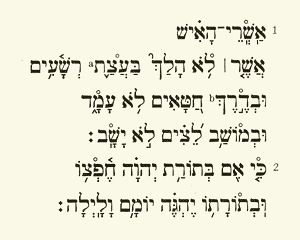
Biblia Hebraica
Encyclopedia
Biblia Hebraica is a Latin phrase meaning Hebrew Bible. It is traditionally used as a title for printed editions of the Tanakh
(Hebrew Bible
).
In current scholarly usage, it refers almost exclusively to the three editions of the Hebrew Bible edited by Rudolf Kittel
(BHK).
When referenced, Kittel's Biblia Hebraica is usually abbreviated BH, or BHK (K for Kittel). When specific editions are referred to, BH1, BH2 and BH3 are used.
 The first two editions of Kittel's Biblia Hebraica appeared in 1906 and 1913; the differences between them are slight, apart from a list of errors in the second. The second edition was reprinted several times. Both editions reproduced the Hebrew text found in the Mikraot Gedolot
The first two editions of Kittel's Biblia Hebraica appeared in 1906 and 1913; the differences between them are slight, apart from a list of errors in the second. The second edition was reprinted several times. Both editions reproduced the Hebrew text found in the Mikraot Gedolot
published by Daniel Bomberg
in Venice
in 1524. These editions did not include Masoretic notes, although the Bomberg's edition did.
Their main feature was their footnotes recording possible corrections to the Hebrew text. Many are based on the Samaritan Pentateuch
and on early Bible translations such as the Septuagint, Vulgate
and Peshitta
; others are conjectural emendations.
. The idea to use that Codex is credited to Paul Kahle. This appeared in installments, from 1929 to 1937, with the first one-volume edition in 1937; it was reprinted many times, with later editions recording variants in the Book of Isaiah
and Habakkuk
from the Dead Sea Scrolls
. It reproduces the Masoretic notes in the Codex exactly, without editing.
.
Tanakh
The Tanakh is a name used in Judaism for the canon of the Hebrew Bible. The Tanakh is also known as the Masoretic Text or the Miqra. The name is an acronym formed from the initial Hebrew letters of the Masoretic Text's three traditional subdivisions: The Torah , Nevi'im and Ketuvim —hence...
(Hebrew Bible
Hebrew Bible
The Hebrew Bible is a term used by biblical scholars outside of Judaism to refer to the Tanakh , a canonical collection of Jewish texts, and the common textual antecedent of the several canonical editions of the Christian Old Testament...
).
In current scholarly usage, it refers almost exclusively to the three editions of the Hebrew Bible edited by Rudolf Kittel
Rudolf Kittel
Rudolf Kittel was a German Old Testament scholar.Kittel studied at Tübingen University. He became Professor of Old Testament at Breslau and Leipzig...
(BHK).
When referenced, Kittel's Biblia Hebraica is usually abbreviated BH, or BHK (K for Kittel). When specific editions are referred to, BH1, BH2 and BH3 are used.
First and second editions

Mikraot Gedolot
The Mikraot Gedolot "Great Scriptures," often called the "Rabbinic Bible" in English, is anedition of Tanakh that generally includes four distinct elements:...
published by Daniel Bomberg
Daniel Bomberg
Daniel Bomberg was an early printer of Hebrew language books. A Christian, born in Antwerp, he was primarily active in Venice between 1516 and 1549....
in Venice
Venice
Venice is a city in northern Italy which is renowned for the beauty of its setting, its architecture and its artworks. It is the capital of the Veneto region...
in 1524. These editions did not include Masoretic notes, although the Bomberg's edition did.
Their main feature was their footnotes recording possible corrections to the Hebrew text. Many are based on the Samaritan Pentateuch
Samaritan Pentateuch
The Samaritan Pentateuch, sometimes called Samaritan Torah, , is a version of the Hebrew language Pentateuch, the first five books of the Bible, used by the Samaritans....
and on early Bible translations such as the Septuagint, Vulgate
Vulgate
The Vulgate is a late 4th-century Latin translation of the Bible. It was largely the work of St. Jerome, who was commissioned by Pope Damasus I in 382 to make a revision of the old Latin translations...
and Peshitta
Peshitta
The Peshitta is the standard version of the Bible for churches in the Syriac tradition.The Old Testament of the Peshitta was translated into Syriac from the Hebrew, probably in the 2nd century AD...
; others are conjectural emendations.
Third edition
The third edition had a slightly different Hebrew text and completely revised footnotes. For the first time, a Bible reproduced the text of the Leningrad CodexLeningrad Codex
The Leningrad Codex is the oldest complete manuscript of the Hebrew Bible in Hebrew, using the masoretic text and Tiberian vocalization. It is dated AD 1008 according to its colophon...
. The idea to use that Codex is credited to Paul Kahle. This appeared in installments, from 1929 to 1937, with the first one-volume edition in 1937; it was reprinted many times, with later editions recording variants in the Book of Isaiah
Book of Isaiah
The Book of Isaiah is the first of the Latter Prophets in the Hebrew Bible, preceding the books of Ezekiel, Jeremiah and the Book of the Twelve...
and Habakkuk
Book of Habakkuk
The Book of Habakkuk is the eighth book of the 12 minor prophets of the Hebrew Bible. It is attributed to the prophet Habakkuk, and was probably composed in the late 7th century BC. A copy of chapters 1 and 2 is included in the Habakkuk Commentary, found among the Dead Sea Scrolls.Chapters 1-2...
from the Dead Sea Scrolls
Dead Sea scrolls
The Dead Sea Scrolls are a collection of 972 texts from the Hebrew Bible and extra-biblical documents found between 1947 and 1956 on the northwest shore of the Dead Sea, from which they derive their name...
. It reproduces the Masoretic notes in the Codex exactly, without editing.
Biblia Hebraica Stuttgartensia
The third edition was superseded by the Biblia Hebraica StuttgartensiaBiblia Hebraica Stuttgartensia
The Biblia Hebraica Stuttgartensia, or ', is an edition of the Masoretic Text of the Hebrew Bible as preserved in the Leningrad Codex, and supplemented by masoretic and text-critical notes...
.

